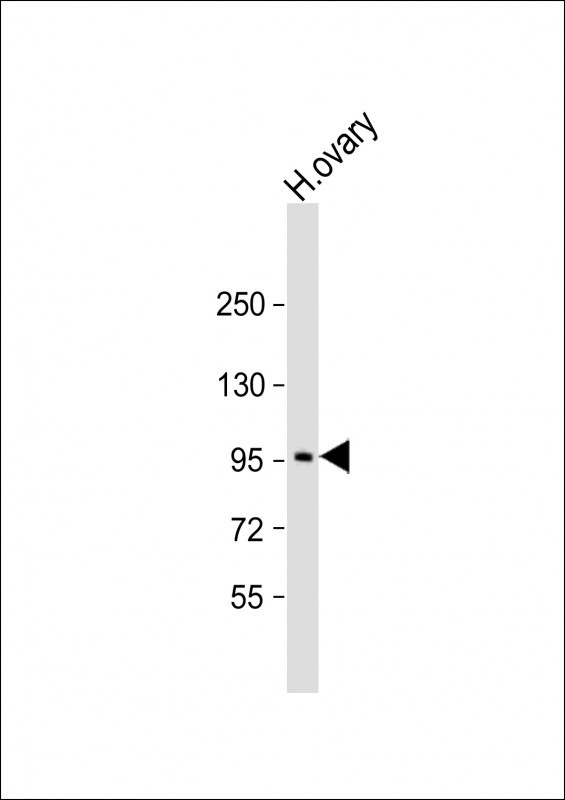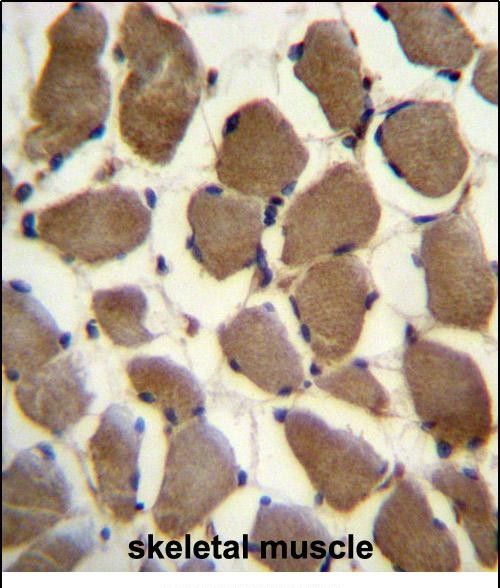LRP3 Antibody (C-term)
Affinity Purified Rabbit Polyclonal Antibody (Pab)
- SPECIFICATION
- CITATIONS
- PROTOCOLS
- BACKGROUND

Application
| IHC-P, WB, E |
|---|---|
| Primary Accession | O75074 |
| Reactivity | Human |
| Host | Rabbit |
| Clonality | Polyclonal |
| Isotype | Rabbit IgG |
| Calculated MW | 82884 Da |
| Antigen Region | 661-692 aa |
| Gene ID | 4037 |
|---|---|
| Other Names | Low-density lipoprotein receptor-related protein 3, LRP-3, 105 kDa low-density lipoprotein receptor-related protein, hLRp105, LRP3 |
| Target/Specificity | This LRP3 antibody is generated from rabbits immunized with a KLH conjugated synthetic peptide between 661-692 amino acids from the C-terminal region of human LRP3. |
| Dilution | IHC-P~~1:10~50 WB~~1:2000 E~~Use at an assay dependent concentration. |
| Format | Purified polyclonal antibody supplied in PBS with 0.09% (W/V) sodium azide. This antibody is purified through a protein A column, followed by peptide affinity purification. |
| Storage | Maintain refrigerated at 2-8°C for up to 2 weeks. For long term storage store at -20°C in small aliquots to prevent freeze-thaw cycles. |
| Precautions | LRP3 Antibody (C-term) is for research use only and not for use in diagnostic or therapeutic procedures. |
| Name | LRP3 |
|---|---|
| Function | Probable receptor, which may be involved in the internalization of lipophilic molecules and/or signal transduction. Its precise role is however unclear, since it does not bind to very low density lipoprotein (VLDL) or to LRPAP1 in vitro. |
| Cellular Location | Membrane; Single-pass type I membrane protein. Membrane, coated pit |
| Tissue Location | Widely expressed. Highly expressed in skeletal muscle and ovary. Expressed at intermediate level in heart, brain, liver, pancreas, prostate and small intestine. Weakly expressed in testis, colon and leukocyte. |

Thousands of laboratories across the world have published research that depended on the performance of antibodies from Abcepta to advance their research. Check out links to articles that cite our products in major peer-reviewed journals, organized by research category.
info@abcepta.com, and receive a free "I Love Antibodies" mug.
Provided below are standard protocols that you may find useful for product applications.
Background
Low density lipoprotein (LDL) receptor-related protein (LRP), a member of the LDL receptor family, binds multiple classes of ligands and has been implicated in a broad range of normal and disease processes involving lipid metabolism, protease clearance, and cell migration (1). Structurally, members of the LDLR family share homology within their extracellular domains, which are highlighted by the presence of clusters of ligand-binding repeats. LRP is a large endocytic receptor that participates in several biological pathways and plays prominent roles in lipoprotein metabolism and in the catabolism of proteinases involved in coagulation and fibrinolysis. LRP also mediates the cellular entry of certain viruses and toxins and facilitates the activation of various lysosomal enzymes (2). All LRPs are expressed in the central nervous system and, for most receptors, animal models have shown that they are indispensable for successful neurodevelopment. The mechanisms by which they regulate the formation of the nervous system are varied and include the transduction of extracellular signals and the modulation of intracellular signal propagation, as well as cargo transport, the function most commonly attributed to this gene family (3).
References
Ishii, H., et al., Genomics 51(1):132-135 (1998).
If you have used an Abcepta product and would like to share how it has performed, please click on the "Submit Review" button and provide the requested information. Our staff will examine and post your review and contact you if needed.
If you have any additional inquiries please email technical services at tech@abcepta.com.













 Foundational characteristics of cancer include proliferation, angiogenesis, migration, evasion of apoptosis, and cellular immortality. Find key markers for these cellular processes and antibodies to detect them.
Foundational characteristics of cancer include proliferation, angiogenesis, migration, evasion of apoptosis, and cellular immortality. Find key markers for these cellular processes and antibodies to detect them. The SUMOplot™ Analysis Program predicts and scores sumoylation sites in your protein. SUMOylation is a post-translational modification involved in various cellular processes, such as nuclear-cytosolic transport, transcriptional regulation, apoptosis, protein stability, response to stress, and progression through the cell cycle.
The SUMOplot™ Analysis Program predicts and scores sumoylation sites in your protein. SUMOylation is a post-translational modification involved in various cellular processes, such as nuclear-cytosolic transport, transcriptional regulation, apoptosis, protein stability, response to stress, and progression through the cell cycle. The Autophagy Receptor Motif Plotter predicts and scores autophagy receptor binding sites in your protein. Identifying proteins connected to this pathway is critical to understanding the role of autophagy in physiological as well as pathological processes such as development, differentiation, neurodegenerative diseases, stress, infection, and cancer.
The Autophagy Receptor Motif Plotter predicts and scores autophagy receptor binding sites in your protein. Identifying proteins connected to this pathway is critical to understanding the role of autophagy in physiological as well as pathological processes such as development, differentiation, neurodegenerative diseases, stress, infection, and cancer.



